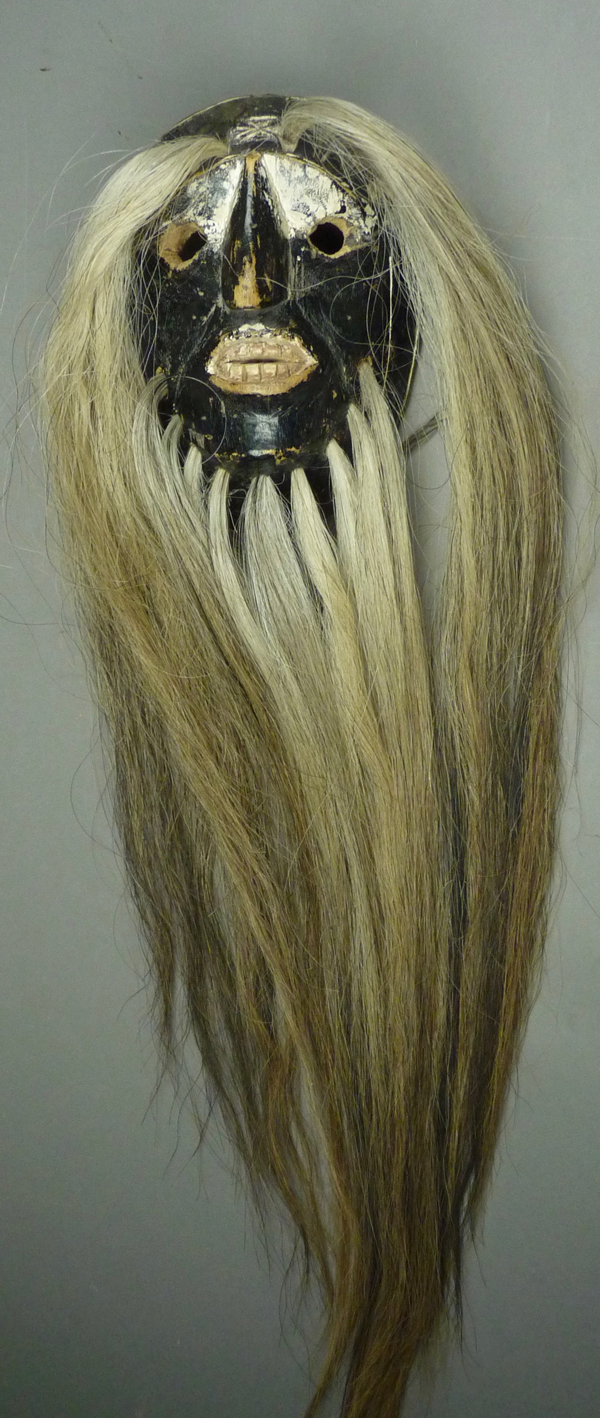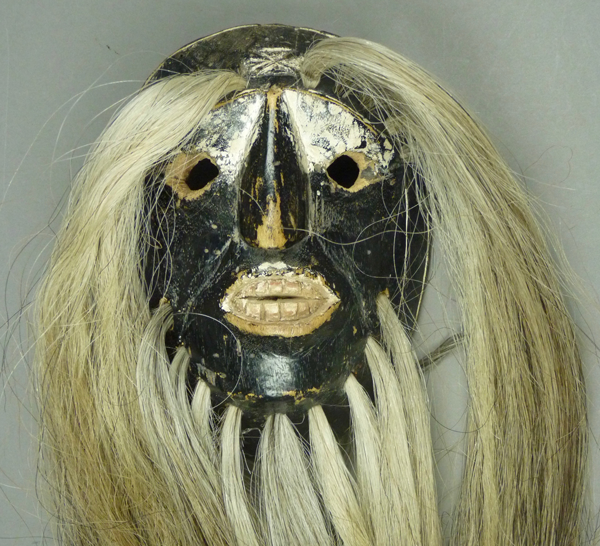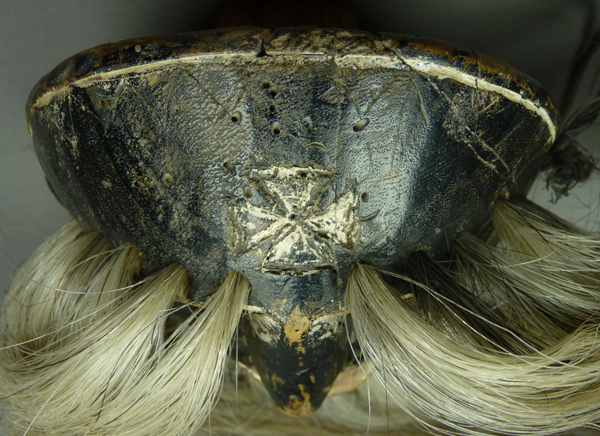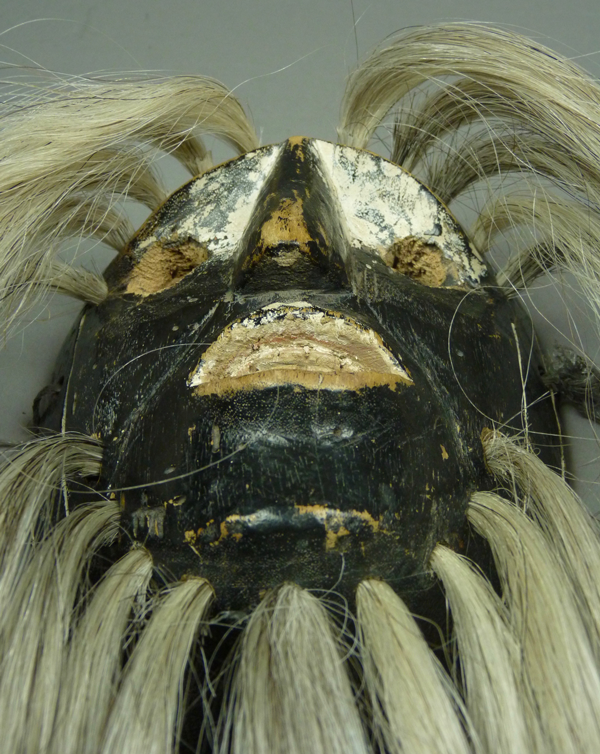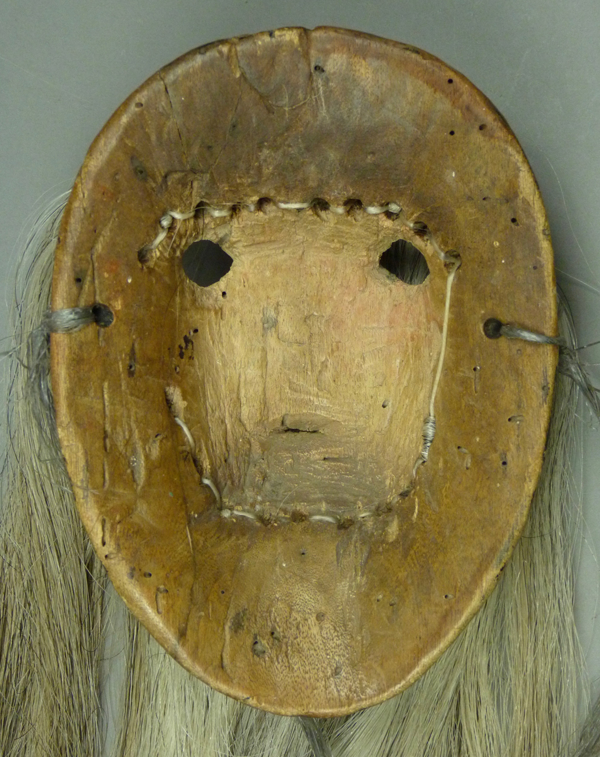I bought today’s mask from Tom Kolaz in March, 2017 . He found it interesting because the Mayo family in Pozo Dulce Sonora who sold it indicated that it had been used by three generations of Pascola dancers. The seller, who was the grandson of the original owner, was 70 years old! The mask had obvious age to support this history, and I suspect that it could easily date to circa 1940 or even earlier. The grandson reported that his grandfather was the carver, but that individual’s name was not recorded. Nor did Tom find the style indicative of a known carver. Therefor I bought it as a terrific, old, but anonymous mask and hung it in a place of honor on the wall, with the expectation that the name of the carver was probably forever lost. As you will see, one aspect of this mask that serves to obfuscate it’s identity is the style of the hair, which is extremely long and silky, of horsetail, copying contemporary Sinaloa Mayo style.
When I looked again at this mask recently, I kept thinking that it had familiar features. Having just studied a number of Rio Mayo Pascola masks for this blog, I am seeing this mask with fresh eyes. At the end of the post I will tell you whose hand I am reminded of, but meanwhile you can play this game for yourself. Here is this week’s mystery mask, and to the right are links to my recent posts about identified Rio Mayo carvers (September, October, and November 2018).
At first glance, the most obvious feature of this mask is the extreme length of the hair, a characteristic found in contemporary Pascola masks made in the Rio Fuerte Mayo villages of Sinaloa. Given its age, this mask has probably been re-haired more than once, and this Sinaloa style hair has been showing up on Yaqui and Rio Mayo masks in recent years.
The forehead cross, in the Maltese or Patée style favored in the Rio Mayo villages, is recessed, meaning gouged out to a degree. The eyes are almond shaped, another common feature of Rio Mayo masks, and the mouth is also typical of this region. It is the nose, and the painting of the spaces over the eyes in a contrasting color that made me think of a familiar carver.
I find myself thinking again of the same carver when I see these simple, excised, and painted (white) lines of the rim design.
The nose has an elegant profile, and might remind us of more than one well-known Rio Mayo carver. It is worn on the tip, and may have lost its original shape to some degree. Please notice how it narrows to a point as it meets the forehead ridge.
The forehead cross is featured in the photo that follows. The edges are deeply incised while the triangular areas within those gouges are mildly recessed.. The white line around the rim (the rim design) is inscribed. If you look very carefully at this photo you may also be able to see incised triangles that were part of an earlier and more elaborate rim design.
There is no evidence of pegs, but of course this is not the original hair. The holes for the hair bundles do have a large bore, suggesting the possibility that the original hair may have had pegs. These large holes are even more easily seen from the back.
There is no evidence of a chin cross.
This mask is 7½ inches tall, 5½ inches wide, and 2½ inches deep. This is shallow for Rio Mayo Pascola masks, and suggests that the mask was originally made for a child. If so, then the grandfather might have worn it for a long long time before passing it on to his son and grandson.
The back of this mask is very darkly stained from long and heavy use. There are those large holes for the hair bundles. Look at the delicate tapering slit on the back that corresponds to the mouth opening on the face of this mask. This is a consistent feature of the same familiar carver of whom I have been reminded. Think for a moment about all the different ways that we have seen Rio Mayo carvers manage this single and relatively insignificant aspect—from no opening at all to a broad opening that provides extensive air flow, and with variations between those two poles such as this one, or another where the teeth are cut through to the back.
It is my impression, on comparison of the eyes, spaces above the eyes, nose, mouth (front and back), and the shaping of the back that this is an old mask by Francisco “Pancho” Parra. You may look again at his masks in my posts of September 10 and 24, 2018, using the link that follows.
https://mexicandancemasks.com/?m=201809
As usual, I have found that the more time that one spends looking at the sculptural details of a mask, the more interesting that mask becomes.
Next week we will examine a mask by Juan Sotomea.
Bryan Stevens

